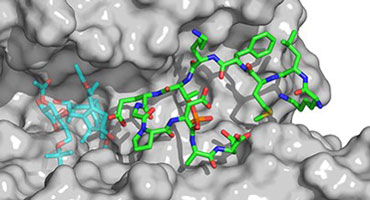Chemistry of Life
Bioactive Molecules

Members: Steve Bull, James Hodgkinson, Richard Hopkinson, Richard Doveston
Bioactive molecules have an effect upon a living organism, tissue, or cell. Such molecules are diverse in size and structure, ranging from large and complex naturally occurring biomolecules such as proteins and oligonucleotides, to small synthetic drugs and probes. Our research seeks to further chemical understanding of the role bioactive molecules play in health and disease, and develop novel chemical approaches for exploiting, controlling or studying their biological effect.
The chemical reactivity of biomolecules such as proteins is an important but often overlooked feature that has profound effects on biological systems. Our experts are investigating how proteins react with endogenous small molecules such as formaldehyde and synthetic cysteine-targeting electrophiles, and how these reactions influence protein structure and function.
Bioactive chemical probes enable the study of biological processes otherwise challenging to study by genetic approaches alone. At Leicester we are developing probes to investigate multi-protein complexes implicated in disease pathways such as those involving histone deacetylase (HDAC) enzymes and hub proteins like 14-3-3. In addition, we have developed probes to quantify cellular formaldehyde levels, and fluorescent sensors to detect analytes such as peroxynitrite in cellular systems.
Our ultimate aim is to develop bioactive molecules with novel therapeutic applications. The development of methodology for the stereoselective synthesis of bioactive molecules is an important aspect of our research which has led to the preparation of natural products, metabolites, pheromones, repellents, and antibiotics. We are also at the forefront of research into small molecule induced protein proximity through the development of heterobifunctional proteolysis targeting chimeras (PROTACs) for HDAC proteins, and molecular glues for 14-3-3 protein-protein interactions.
Working with: Leicester Institute for Structural and Chemical Biology, LD3, Leicester Cancer Research Centre